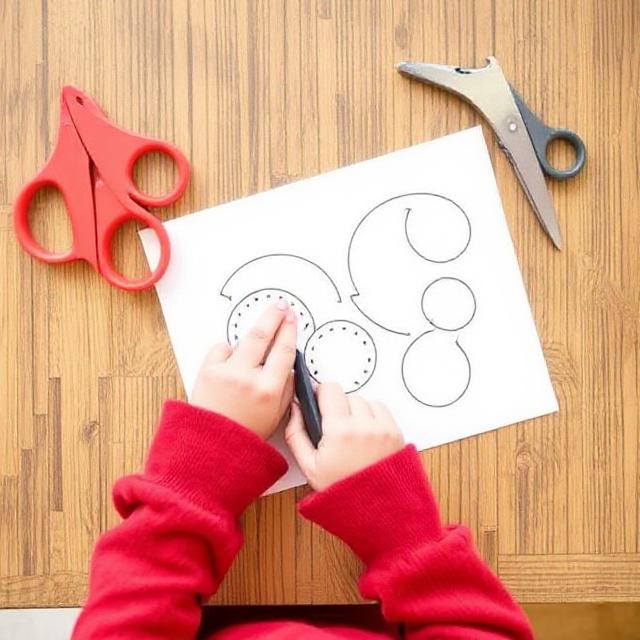Introduciotn to Cutting Activities for Preschoolers
Introducing preschoolers to cutting activities for Preschoolers can be a fantastic way to develop fine motor skills, hand-eye coordination, and concentration. However, selecting appropriate cutting activities requires careful consideration to ensure safety, engagement, and developmental appropriateness. This article explores essential factors to consider and practical tips to choose the best cutting activities for preschoolers.
Understanding the Importance of Cutting Activities for Preschoolers
Cutting activities for Preschoolers are fundamental in early childhood development. They help strengthen the small muscles in children’s hands, which are vital for later skills such as writing, drawing, and self-care tasks like buttoning and zipping. Moreover, engaging in cutting activities fosters concentration, patience, and precision.
Safety First: Choosing Age-Appropriate Materials
Safety is paramount when selecting cutting activities for preschoolers. Children in this age group are still developing their fine motor skills and may lack full control over scissors, which can pose risks.
- Use Child-Safe Scissors: Always opt for scissors designed specifically for preschoolers. These typically have rounded tips, plastic blades, and ergonomic handles that fit small hands comfortably.
- Avoid Sharp or Metal Scissors: Never give young children adult or sharp scissors, as they can cause injuries.
- Supervision: Always supervise cutting activities for Preschoolers closely. Ensure children are seated properly and handling scissors with care.
Developmental Readiness: Assessing Skill Levels
Preschoolers’ abilities vary widely, so it’s essential to match activities with their developmental stage.
- Beginner Level: For children just starting out, focus on simple tasks like snipping along straight lines or cutting out basic shapes such as circles or squares.
- Intermediate Level: As they gain confidence, introduce more complex tasks like cutting along curved lines or zigzag patterns.
- Advanced Level: For older preschoolers with better coordination, try cutting out intricate shapes or following dotted lines.
Choosing Suitable Materials
The materials children cut should be engaging, safe, and manageable.
- Paper Types: Start with lightweight, easy-to-cut paper such as construction paper, craft foam sheets, or magazine pages. Avoid thick cardboard initially, as it can be difficult for small scissors.
- Shape and Pattern Templates: Use printed templates with clear lines for children to follow. These can include simple shapes, animals, or objects.
- Pre-Cut Shapes: Provide pre-cut shapes for children to assemble or decorate, fostering creativity and confidence before they attempt free cutting.
Incorporating Fun and Engagement
Cutting activities for Preschoolers should be enjoyable to motivate children to practice and develop their skills.
- Themed Activities: Connect cutting exercises to themes children enjoy, like cutting out shapes of animals, flowers, or holiday symbols.
- Storytelling: Create stories or scenarios around the activity, such as “cutting out leaves for a tree” or “making a zoo with animal shapes.”
- Creative Art Projects: Use cutting as part of larger art projects, such as collages or card-making, to make the activity meaningful.
Gradually Increasing Complexity
As children improve, gradually introduce more challenging tasks.
- Line Following: Use dotted or dashed lines for children to follow with scissors.
- Symmetrical Cutting: Encourage cutting along lines that create symmetrical shapes or patterns.
- Multiple Cuts: Challenge children to make several cuts to create more complex designs.
Providing Proper Tools and Support
- Ergonomic Handles: Choose scissors with handles that fit small hands comfortably.
- Guidance and Demonstration: Demonstrate proper cutting techniques, such as how to hold scissors and how to open and close them smoothly.
- Positive Reinforcement: Praise children for their efforts to build confidence and encourage perseverance.
Observing and Adjusting Activities
Monitor children’s progress and adjust activities accordingly.
- Assess Comfort and Control: If a child struggles significantly, simplify the task or provide additional support.
- Encourage Independence: As skills develop, encourage children to attempt tasks independently, fostering confidence and autonomy.
Promoting Safety and Proper Technique
Teach children safety rules to prevent accidents.
- Hold Scissors Correctly: Show how to hold scissors with the thumb in one handle and fingers in the other.
- Cut Away from the Body: Emphasize cutting away from oneself to avoid injuries.
- Stay Focused: Encourage children to pay attention and avoid rushing.
Summary: Making Cutting Activities Effective and Enjoyable
Choosing suitable cutting activities for preschoolers involves balancing safety, developmental appropriateness, engagement, and progression. Start with simple, safe materials and tasks, and gradually introduce more complex projects as children develop their skills. Incorporate themes and creative elements to make the activities enjoyable, and always supervise closely to ensure safety.
By thoughtfully selecting and structuring cutting activities for Preschoolers, educators and parents can foster essential fine motor skills while nurturing a child’s confidence and love for learning. Remember, the goal is to provide a supportive environment where children can explore and develop at their own pace, making each cutting activity a fun and rewarding experience.



